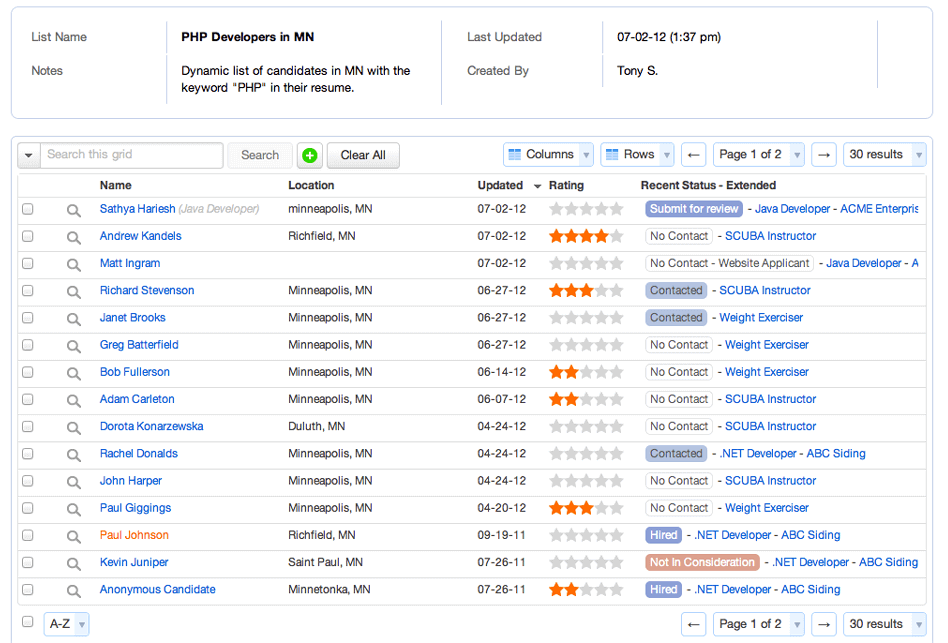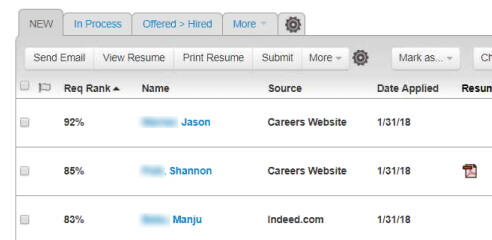What do you know about applicant tracking systems?
If you think the first obstacle to getting a job interview is a recruiter’s judgment, you’re not seeing the whole picture. 99% of Fortune 500 companies and a growing number of small and mid-sized businesses filter resumes through an applicant tracking system (ATS) before someone takes a look… if they ever do.
Learn how ATS work, what they do to your resume, and how to beat ATS so that your resume gets seen by the human decision makers who schedule job interviews.
1. What are applicant tracking systems?
Applicant tracking system software provides recruiting and hiring tools for companies. Among other functions, these systems collect and sort thousands of resumes.
Read full article: What is an applicant tracking system?
When you apply for a job online, your resume isn’t typically going directly to a recruiter or hiring manager. It’s first being processed by an ATS. Whether that human recruiter ever sees your resume could depend on how well your resume is optimized for ATS algorithms.
2. Why employers use applicant tracking systems
Top employers hire for several jobs at a time and receive hundreds of resumes for any given opening. Because applying for a job online is easier than ever, many of these applicants are unqualified and figured “it was worth a try.”
Applicant tracking systems keep all these resumes in one place, helping recruiters and hiring managers stay organized as well as EEOC compliant. In theory, these systems also save time by automatically surfacing and highlighting top candidates. In reality, ATS do help hiring professionals narrow their applicant pool, but top candidates slip through the cracks.
 CATSone ATS applicants
CATSone ATS applicants
3. Applicant tracking systems are everywhere
Most large corporations utilize applicant tracking systems. Jobscan research found that 98% of Fortune 500 companies use ATS while a Kelly OCG survey estimated 66% of large companies and 35% of small organizations rely on recruitment software.
There are dozens of different ATS, each with their own features, strengths, weaknesses, and quirks. Here are just a few of the top ATS:
| Taleo | Workday | SuccessFactors | Greenhouse |
| Brassring | iCIMS | Jobvite | Lever |
| SmartRecruiters | JazzHR | CATS | BambooHR |
If you’re applying to a large organization, chances are you’ll face an ATS. If you’re applying through any online form, you’re applying through an ATS. Even job sites like Indeed and LinkedIn have their own built in ATS.
4. How applicant tracking systems work
Applicant tracking systems collect and store resumes in a database for hiring professionals to access. Resumes may also be stored long after the original job you applied for is filled. Corporate recruiters or hiring managers can then search and sort through the resumes in a number of ways, depending on the system they’re using.
Viewing Applications
Some recruiters still choose to glance at every job application that comes through their applicant tracking system. In this case, most take a quick glance at the applicant’s past highlights, job titles, and companies. They can make a determination about whether they want to learn more in about 6 seconds. It’s important to make sure your top skills and qualifications are easily identifiable.
Automatic Rankings
Some applicant tracking systems can automatically compare your resume to the job description. For example, Taleo calls this feature “Req Rank,” which ranks each applicant based on how well their resume scores based on the job description.
 Candidates ranked based on job requisition match in Taleo.
Candidates ranked based on job requisition match in Taleo.
Instead of reviewing each and every application, the recruiter can focus squarely on candidates the ATS has identified as a great match.
Keyword Searches
A common way recruiters filter resumes in an applicant tracking system is by searching for key skills and titles.
For example, if a recruiter is hiring for an Administrative Assistant position out of 400 resumes, their first step will probably be a search for “Administrative Assistant.” This will isolate candidates that have done the exact job before. Anyone that doesn’t have that exact term in their resume is out of luck.
A search can contain multiple terms. For example, they might perform a complex search that contains a combination of titles and skills important for the job:
Administrative Assistant AND data entry AND payroll …
Candidates who can predict the correct resume keywords will have the greatest chance of being included in recruiter search results. The best way to figure out which skills and keywords to include is by analyzing the job description.
Jobscan automates this process by analyzing your resume against the job description to show the top skills and keywords missing from your resume.
 Hard skills comparison in Jobscan. Click to see full example.
Hard skills comparison in Jobscan. Click to see full example.
5. Resume formatting matters in applicant tracking systems
When you upload your resume into an applicant tracking system, the recruiter won’t necessarily view the file. Some ATS parse the document into a digital profile to make things uniform and searchable.
This causes big problems for job seekers.
Many ATS parsing algorithms are outdated and unintelligent, causing your resume information to get distorted or lost. This means vital keywords or details might not be imported. Imagine your most important qualification slipping through the cracks!
Modern ATS are starting to get away from this practice, but some popular systems like iCIMS (used by Amazon, General Mills, Comcast) still do it. In order to create an ATS-friendly resume that is parsable by these outdated systems, be sure to keep section headings simple, use consistent formatting for your work history and dates, avoid tables, and use a .docx or .pdf file format.
6. How to beat applicant tracking systems
There is no universal trick to “beating” applicant tracking systems. Getting past an ATS and landing a job interview requires a well-written resume that is mindful of ATS algorithms as well as the people pushing the buttons.
Here’s our simplest advice for how to beat ATS:
- Carefully tailor your resume to the job description every single time you apply.
- Optimize for ATS search and ranking algorithms by matching your resume keywords to the job description
- Use both the long-form and acronym version of keywords (e.g. “Master of Business Administration (MBA)” or “Search Engine Optimization (SEO)”) for maximum searchability
- Use a chronological or hybrid resume format (avoid the functional resume format)
- Don’t use tables or columns as they often cause major parsing errors
- Use a traditional resume font like Helvetica, Garamond, or Georgia
- Don’t use headers or footers as the information might get lost or cause a parsing error
- Use standard resume section headings like “Work Experience” rather than being cute or clever (“Where I’ve Been”)
- Save your file as a .docx if possible
7. Don’t cheat or over-optimize for applicant tracking systems
Optimizing your keywords and formatting for applicant tracking systems is notthe same as cheating the system.
In theory, you can trick ATS algorithms by stuffing your resume with keywords. Some do this by secretly adding additional keywords to their resumes using “invisible” white text or by unnaturally overusing keywords.
Full article: Are You Guilty of Resume Keyword Stuffing?
These tricks might help you get a better initial score in the ATS, but they’re unlikely to fool recruiters. Instead of getting yourself blacklisted from the company, focus on crafting the best resume possible based on your actual skillset.
8. Applicant tracking systems are here to stay
During the Great Recession, employers were flooded with applications and wanted features that discouraged and filtered out unqualified candidates. This resulted in many of the bloated application processes and indiscriminate filters found in ATS today. Unfortunately, improving unemployment rates won’t mark the end of ATS.
While outdated systems are still in use at some large companies, we are seeing new ATS being developed for the modern age. As employers fight for the best talent, candidate experience is becoming more of a priority. Automation and ranking systems aren’t going away; they’re just becoming more technical as recruiting software begins leveraging AI.
An ATS-optimized resume is the first step to getting past the bots and face to face with an actual person. Jobscan tests and researches common ATS to help job seekers avoid the traps of these systems, from the outdated to the cutting edge.
Source: Jobscan


